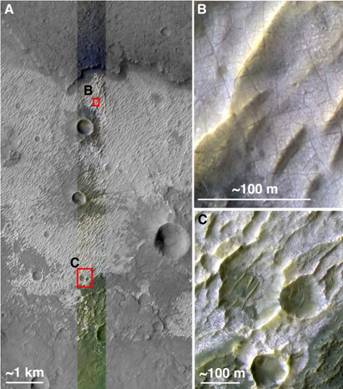22 March 2008

This image provides higher-resolution views of a site where another observation indicates the presence of chloride salt deposits.
Credit: NASA/JPL-Caltech/University of Arizona/Arizona State University/University of Hawaii
NASA's Mars Odyssey orbiter has found evidence of salt deposits. These deposits point to places where water once was abundant and where evidence might exist of possible ancient Martian life.
A research team led by Mikki Osterloo (University of Hawaii) found approximately 200 sites on southern Mars that show spectral characteristics consistent with chloride minerals. Chloride is part of many types of salt, such as sodium chloride or table salt. The sites range from about one kilometer squared in area to 25 times that size.
"They could come from groundwater reaching the surface in low spots," said Osterloo. "The water would evaporate and leave mineral deposits, which build up over years. The sites are disconnected, so they are unlikely to be the remnants of a global ocean."
Scientists applied Odyssey's Thermal Emission Imaging System to take images in visible light and infrared. The infrared wavelengths enable the identification of various minerals and rocks on the Martian surface.
Osterloo spotted the sites by examining thousands of images specially processed to reveal compositional differences on the Martian surface. Plotted on a Mars map, the chloride sites appear only in the southern highlands, the most ancient rocks on Mars.
"Many of the deposits lie in basins with channels leading into them," said Philip Christensen, co-author and principal investigator. "This is the kind of feature, like salt-pan deposits on Earth, that's consistent with water flowing in over a long time."
Scientists believe the salt deposits are approximately 3.5 to 3.9 billion years old. Several lines of evidence suggest Mars then had intermittent periods with substantially wetter and warmer conditions than the modern dry, cold climate.
Scientists searching for evidence of past life on Mars have concentrated mainly on a handful of places that show evidence of clay or sulfate minerals. Clays indicate weathering by water, and sulfates may have formed by water evaporation. The new study, however, proposes an alternative mineral target to explore for biological remains.
The question whether life ever has existed on Mars is a challenge driving Mars research. On Earth, salt is efficient for preserving organic material. Bacteria have been revived in the laboratory after being preserved in salt deposits for millions of years.
"This discovery demonstrates the continuing value of the Odyssey science mission, now entering its seventh year. The more we look at Mars, the more fascinating a place it becomes," said Jeffrey Plaut, Odyssey project scientist at NASA's Jet Propulsion Laboratory (JPL).
"This is a wonderful and scientifically exciting result obtained from a relatively low cost NASA Mars orbiter mission which still has years of life left," said Alan Stern, Associate Administrator for NASA's Science Mission Directorate. "Hold on to your hats, more exciting results from Mars are sure to be coming."
Further Reading
Mars Odyssey
http://www.nasa.gov/mission_pages/odyssey/
JPL News Release
http://www.jpl.nasa.gov/news/news.cfm?release=2008-047
Aymen Mohamed Ibrahem
Senior Astronomy Specialist